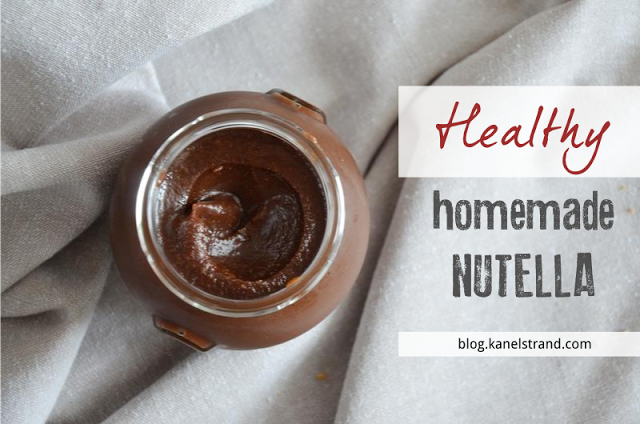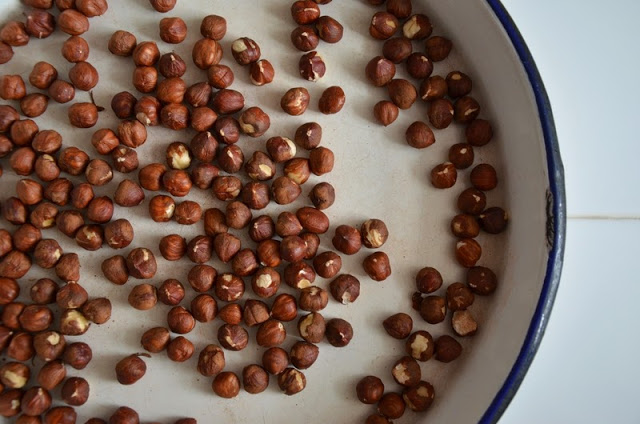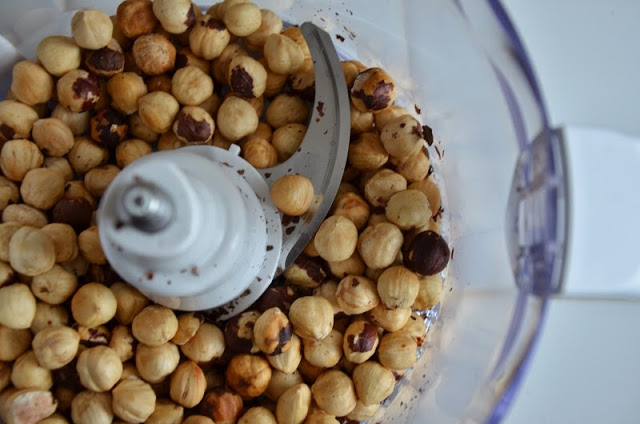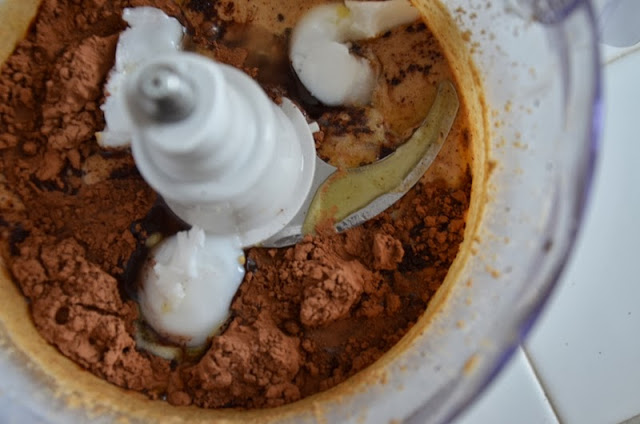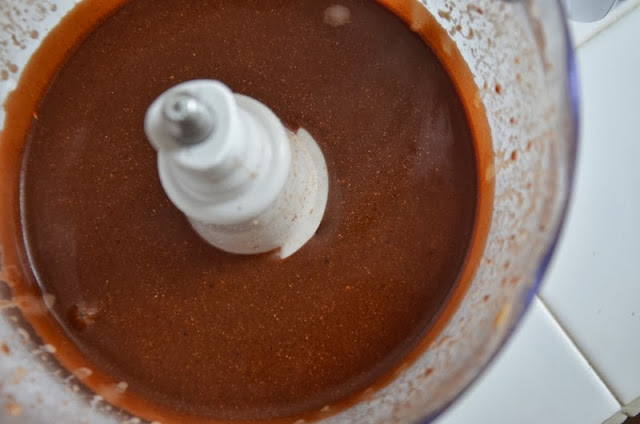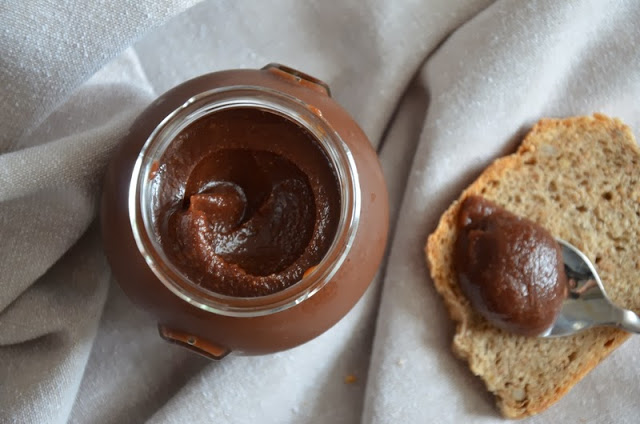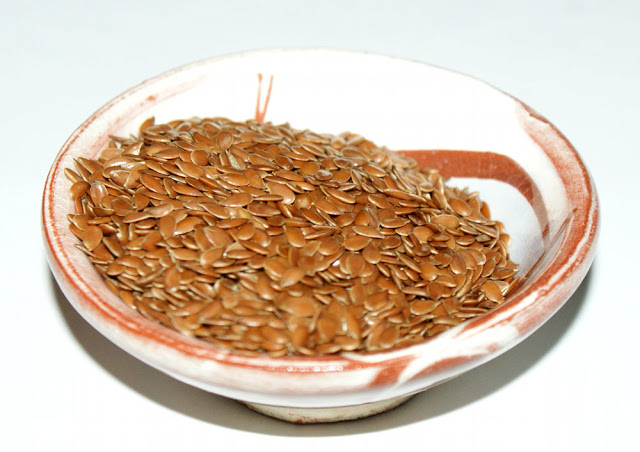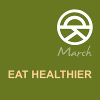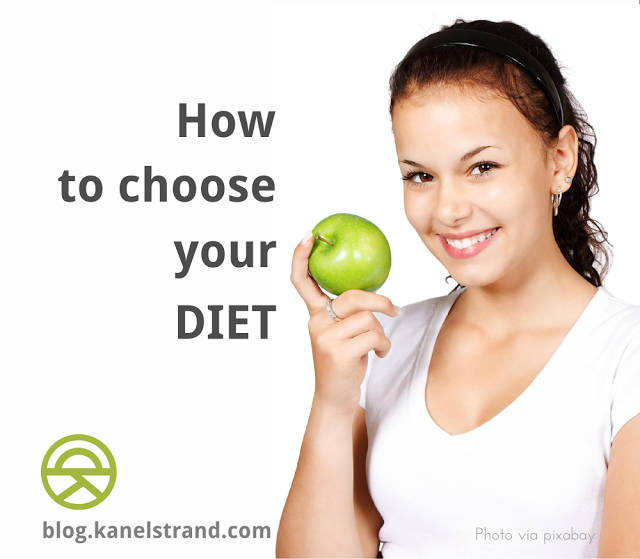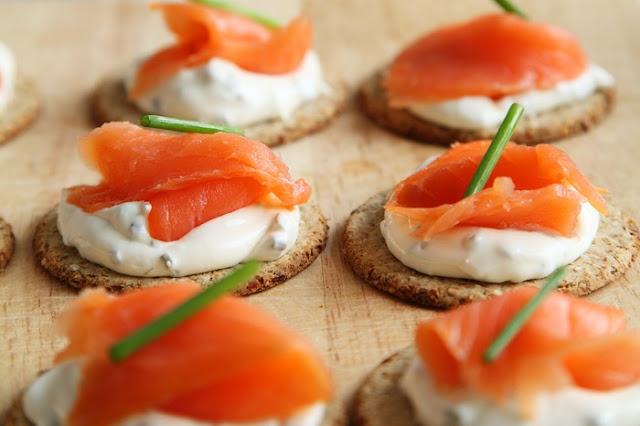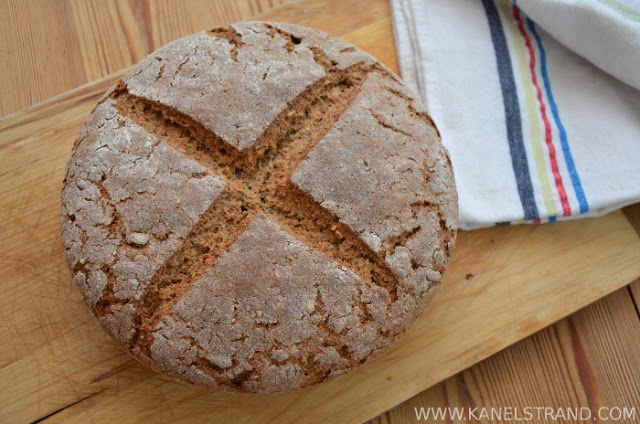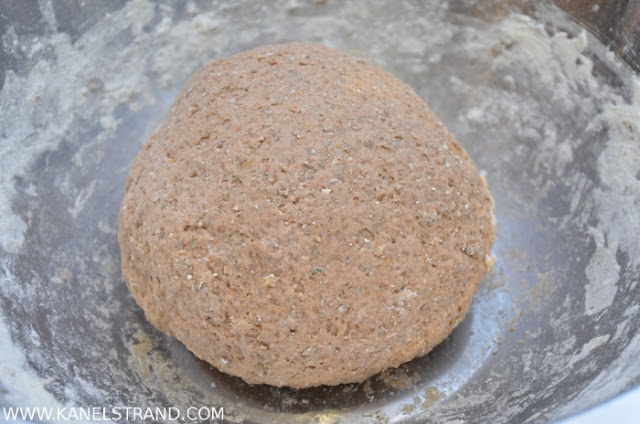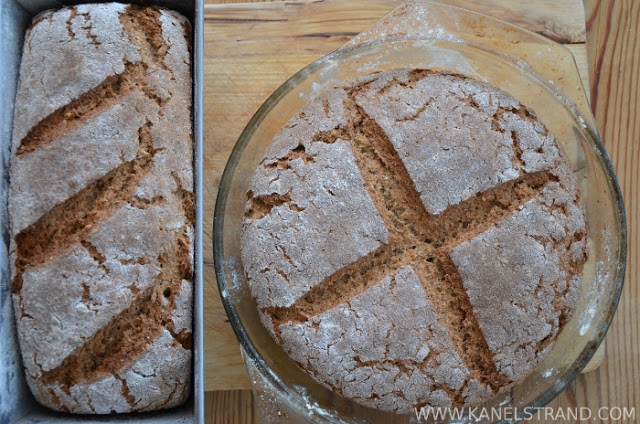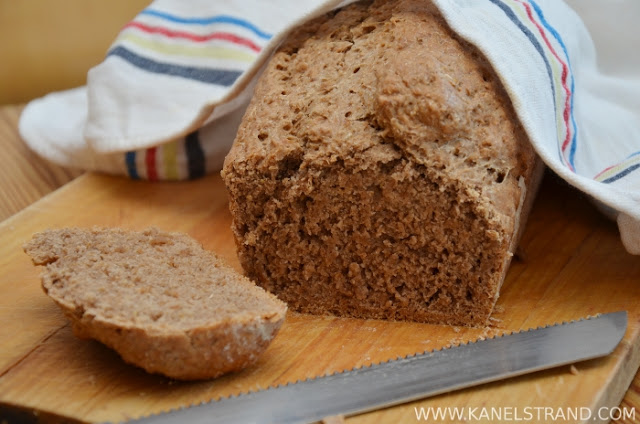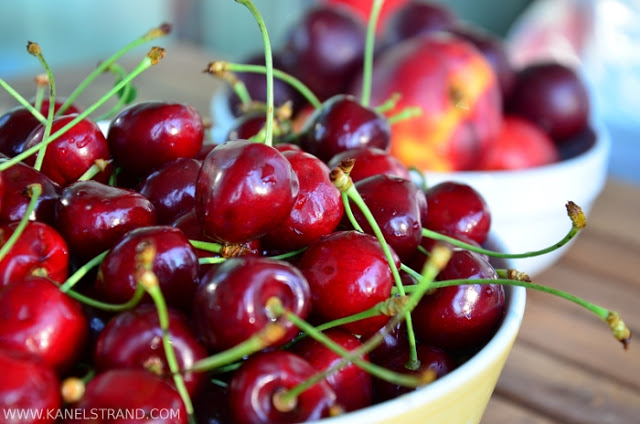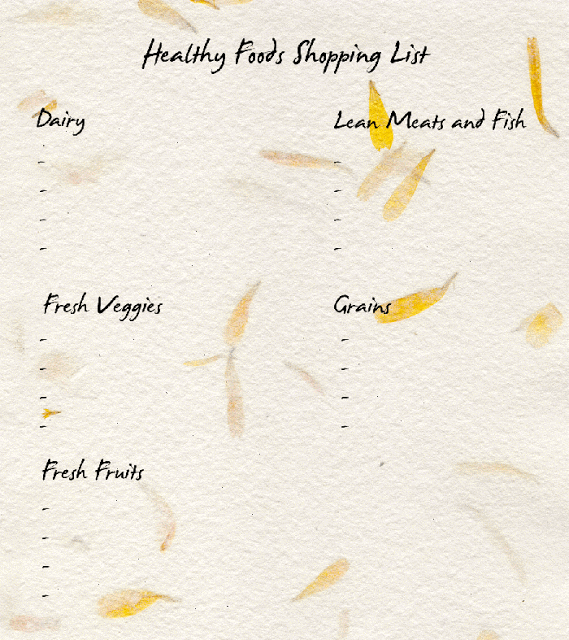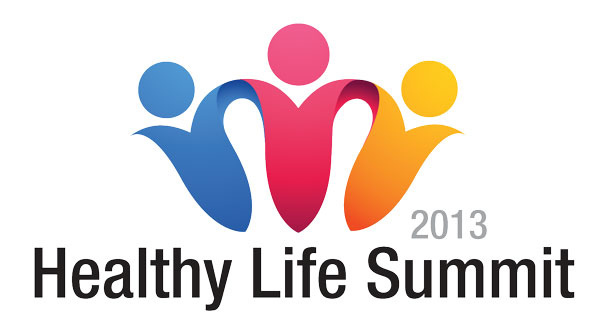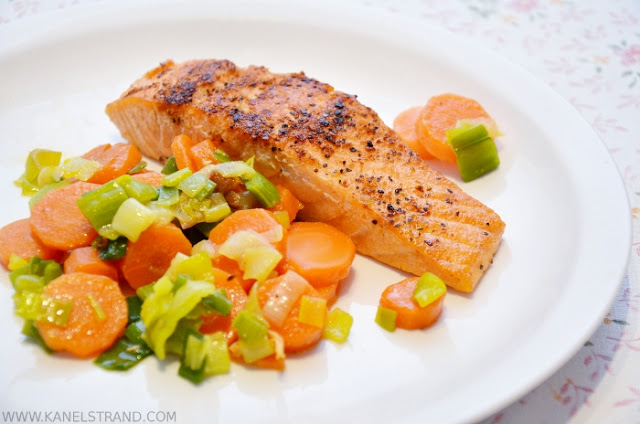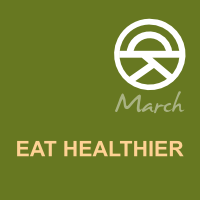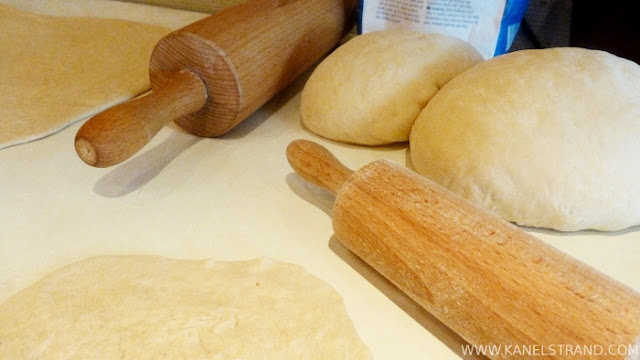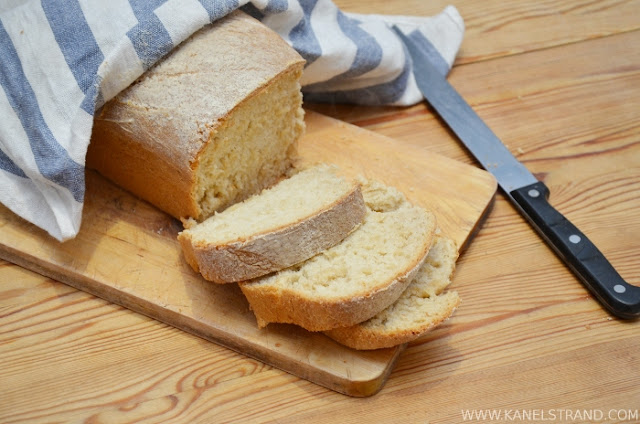If you love to cook from scratch you sure have invented some kitchen hacks to save you time and effort. For example, I have my own special way of arranging the spice jars, so I can pick them without looking, and I peel the onions after I've soaked them in water for faster and easier results.
But one thing I've always had trouble with is deseeding a pomegranate. I do love to eat pomegranate when possible but the effort it takes to open and deseed it often reduces my appetite for it.
That is why I was super-excited to find a great way to deseed a pomegranate in just a couple of minutes. Take a look:
If you are a fan of kiwi but don't know how to peel it without loosing too much of it, here is another video for you.
If you are a potato lover like me, you have spent countless hours peeling potatoes, here is a quick tip to peel potatoes with your bare hands.
I am sure that most of you already know that the easiest way to peel a garlic clove is to squash it with the knife and then it comes right out of its papery peel but what if you need to peel more cloves? Here is a great way to peel 20 garlic cloves in 20 seconds.
And now, here is the coolest way to peel hard boiled eggs perfectly.
Now it's your turn. Share the kitchen hacks that have made your life easier!
Showing posts with label healthy kitchen. Show all posts
Showing posts with label healthy kitchen. Show all posts
14 February 2014
20 December 2013
Healthy Homemade Nutella Recipe (Vegan)
I have almost stopped buying sweets. Not because I don't like them but because I am disgusted by the amount of unhealthy, chemically-enhanced ingredients they contain, and of course the sweeteners in all forms. With commercial sweets and ice-cream I said good bye to Nutella as well.
Why? Because although Nutella is marketed as "hazelnut cream", its main ingredients are sugar and palm oil, followed by hazelnut, cocoa solids, and skimmed milk. Actually Nutella is 55% sugar! In the United States, Nutella contains soy products. Read the correct list of Nutella ingredients. About half of the calories in Nutella come from fat (11 g in a 37 g serving, or 99 kcal out of 200 kcal) and about 40% of the calories come from sugar (20 g, 80 kcal).
I have already reduced to a minimum the use of refined white sugar but palm oil is so hard to avoid in commercial products nowadays. Not only is palm oil proven to increase blood cholesterol levels and to contribute to heart disease but according to Climate Mama it also contributes to climate change. Often, the agricultural practices used to produce palm oil in Indonesia and Malaysia (where 80% of palm oil is produced) have a negative impact not only on the wildlife, and our environment but also on our increasingly limited “carbon budget.”
Being a health- and environmentally conscious chocolate lover I got super excited when I found the recipe for homemade Nutella by the Coconut Mama and hurried to the market to buy some hazelnuts and start blending.
While Nutella provides very little in the way of good nutrition (not much protein, fiber, vitamins, minerals - the nutrients we are lacking) this homemade sugar-free version is not just vegan, it's healthy.
So, here is the (slightly adjusted) recipe, accompanied by step-by-step instructions for a healthy guilt-free "Nutella" indulgence!
Ingredients:
Directions:
1. Preheat the oven to 350°F (176°C).
2. Spread the hazelnuts in a single layer on a baking sheet.
3. Toast the hazelnuts in the oven for about 12 minutes, until they get slightly brown and the skins are blistered a little.

4. Wrap them in a kitchen towel and rub vigorously to remove as much loose skin as possible. Some skin will cling to the nuts but that is ok. Let cool completely and put in a food processor.
5. Blend the hazelnuts until they form nut butter.
6. Now add all the other ingredients and only half of the required milk.
7. Blend again. If you like the consistency, leave it like that, if not just pour the rest of the milk.
And voilà! You have a rich nutty, chocolatey treat that is also healthy!
References:
http://en.wikipedia.org/wiki/Palm_oil#Health
http://climatemama.com/blog/6595
http://foodwatch.com.au/blog/additives-and-labels/item/nutella-the-full-correct-list-of-ingredients.html
This post was shared here:
Real Food Wednesdays
Raising Homemakers
Motivation Monday
Sweet Sharing Monday
Plant-Based Potluck Party
Why? Because although Nutella is marketed as "hazelnut cream", its main ingredients are sugar and palm oil, followed by hazelnut, cocoa solids, and skimmed milk. Actually Nutella is 55% sugar! In the United States, Nutella contains soy products. Read the correct list of Nutella ingredients. About half of the calories in Nutella come from fat (11 g in a 37 g serving, or 99 kcal out of 200 kcal) and about 40% of the calories come from sugar (20 g, 80 kcal).
I have already reduced to a minimum the use of refined white sugar but palm oil is so hard to avoid in commercial products nowadays. Not only is palm oil proven to increase blood cholesterol levels and to contribute to heart disease but according to Climate Mama it also contributes to climate change. Often, the agricultural practices used to produce palm oil in Indonesia and Malaysia (where 80% of palm oil is produced) have a negative impact not only on the wildlife, and our environment but also on our increasingly limited “carbon budget.”
Being a health- and environmentally conscious chocolate lover I got super excited when I found the recipe for homemade Nutella by the Coconut Mama and hurried to the market to buy some hazelnuts and start blending.
While Nutella provides very little in the way of good nutrition (not much protein, fiber, vitamins, minerals - the nutrients we are lacking) this homemade sugar-free version is not just vegan, it's healthy.
So, here is the (slightly adjusted) recipe, accompanied by step-by-step instructions for a healthy guilt-free "Nutella" indulgence!
Ingredients:
- 2 cups hazelnuts
- 3 tablespoons coconut oil
- 6 tablespoons unsweetened cocoa powder
- 2/3 cup honey
- 1/2 cup rice milk
- 1/8 teaspoon salt
Yields about 1,1 lb (500 g) of delicious homemade Nutella.
1. Preheat the oven to 350°F (176°C).
2. Spread the hazelnuts in a single layer on a baking sheet.
3. Toast the hazelnuts in the oven for about 12 minutes, until they get slightly brown and the skins are blistered a little.

4. Wrap them in a kitchen towel and rub vigorously to remove as much loose skin as possible. Some skin will cling to the nuts but that is ok. Let cool completely and put in a food processor.
5. Blend the hazelnuts until they form nut butter.
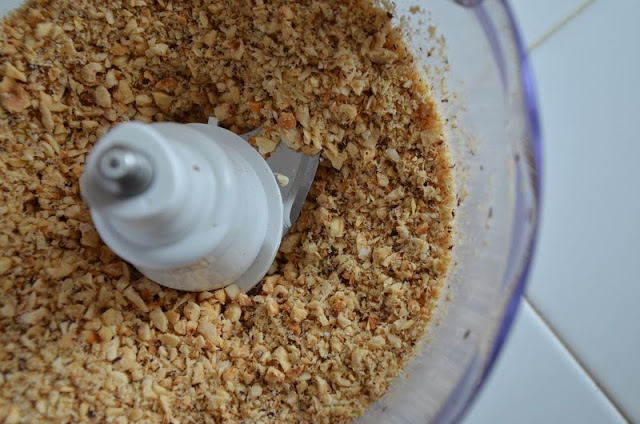 |
| Not ready. |
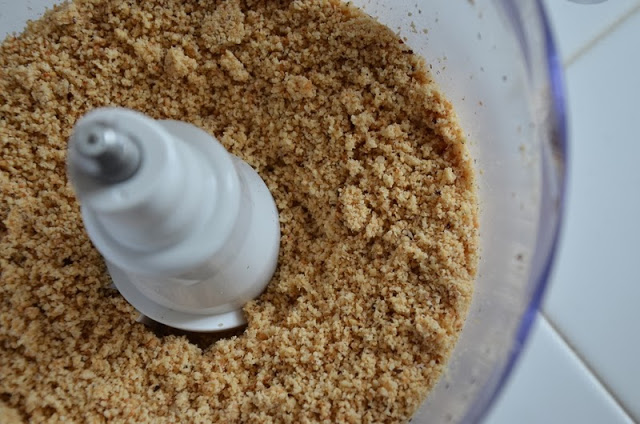 |
| Not ready yet. |
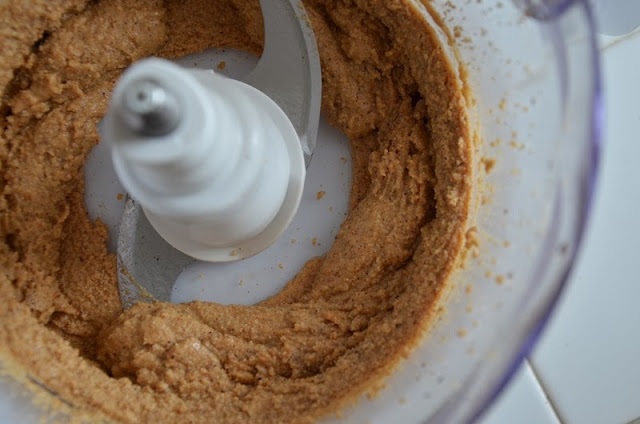 |
| Close. |
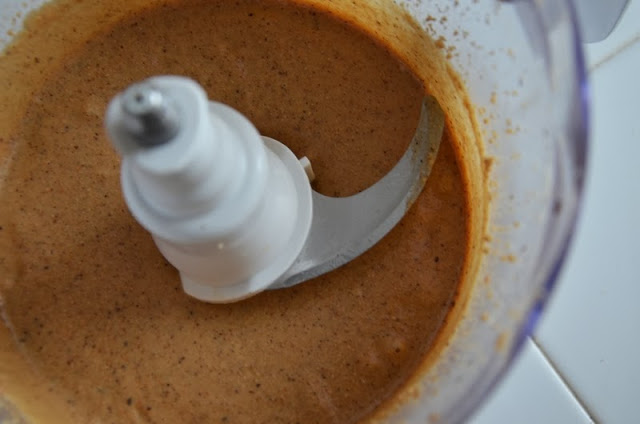 |
| Perfect! |
6. Now add all the other ingredients and only half of the required milk.
7. Blend again. If you like the consistency, leave it like that, if not just pour the rest of the milk.
And voilà! You have a rich nutty, chocolatey treat that is also healthy!
References:
http://en.wikipedia.org/wiki/Palm_oil#Health
http://climatemama.com/blog/6595
http://foodwatch.com.au/blog/additives-and-labels/item/nutella-the-full-correct-list-of-ingredients.html
This post was shared here:
Real Food Wednesdays
Raising Homemakers
Motivation Monday
Sweet Sharing Monday
Plant-Based Potluck Party
24 July 2013
Detoxify Your Body With Homemade Apple Cider Vinegar
Did you know that Apple Cider Vinegar that we all have in our kitchens has the ability to detoxify and cleanse our bodies? It also improves blood circulation, and supplies the organism with minerals and vitamins. Apple Cider Vinegar is particularly valuable when combined with honey.
Here are some easy to follow recipes including Apple Cider Vinegar that will help detoxify your body.
Homemade Apple Cider Vinegar
Ingredients:
11 lb (5 kg) ripe apples
0.55 lb (250 g) boiled water
0.44 lb (200 g) honey
Method:
Finely grate 5 kg ripe apples with the peels. Fill 1/4 of a 10-liter bottle with boiled and cooled water. Add the grated apples and 200 grams of honey. Close the bottle and shake well, then loosen the cap to allow air inside. Don't fill the bottle to the top and leave some space to prevent the content from overflowing during the fermentation process, which should take about 40 days. When the fruit settles at the bottom, strain through a fine gauze. Leave the vinegar for another 40 days to rest and settle. Finish the process by straining one last time and pour your homemade Apple Cider Vinegar into bottles.
Do you know any other recipes to make your own homemade Apple Cider Vinegar? Share with us in the comments.
Here are some easy to follow recipes including Apple Cider Vinegar that will help detoxify your body.
- Half an hour before each meal (three times a day) drink 1 cup of water with 1 tablespoon natural Apple Cider Vinegar and 1 tbsp honey.
- Boost the health of the whole family with a sweet-and-sour salad dressing. Mix 1/4 cup vinegar, 1/4 cup corn oil and 1/2 cup honey and pour over your salad.
- Detoxify your body by drinking 1 cup of water with 1 tablespoon vinegar every morning.
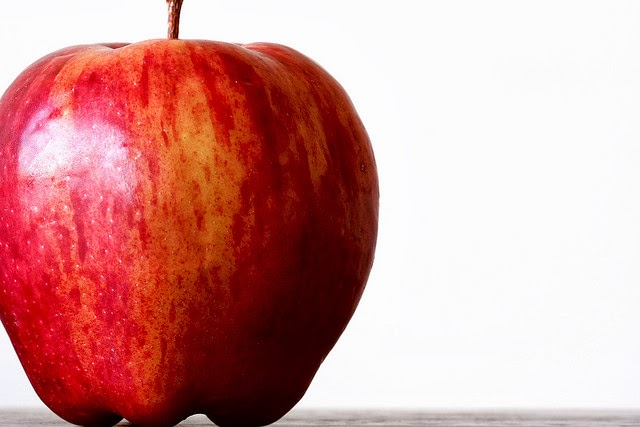 |
| Photo: David Lifson |
Homemade Apple Cider Vinegar
Ingredients:
11 lb (5 kg) ripe apples
0.55 lb (250 g) boiled water
0.44 lb (200 g) honey
Method:
Finely grate 5 kg ripe apples with the peels. Fill 1/4 of a 10-liter bottle with boiled and cooled water. Add the grated apples and 200 grams of honey. Close the bottle and shake well, then loosen the cap to allow air inside. Don't fill the bottle to the top and leave some space to prevent the content from overflowing during the fermentation process, which should take about 40 days. When the fruit settles at the bottom, strain through a fine gauze. Leave the vinegar for another 40 days to rest and settle. Finish the process by straining one last time and pour your homemade Apple Cider Vinegar into bottles.
Do you know any other recipes to make your own homemade Apple Cider Vinegar? Share with us in the comments.
27 March 2013
Flax Seed as Part of a Healthy Diet
This post is written by contributing author Rebecca D. Dillon.
I've really tried to make improvements in my diet over the past year. By cutting way down on carbs like pasta and breads - which I rarely eat now - as well as white potatoes, I was able to go down two pant sizes. In doing this, I also started taking a look at new foods I hadn't tried before.
I've really tried to make improvements in my diet over the past year. By cutting way down on carbs like pasta and breads - which I rarely eat now - as well as white potatoes, I was able to go down two pant sizes. In doing this, I also started taking a look at new foods I hadn't tried before.
One of my favorite new foods I discovered during this process was flax seed. Not only does flax seed taste surprisingly good, but it's also believed to help reduce your risk of heart disease, stroke, diabetes, inflammation, lung disease, breast, colon and prostate cancer - even hot flashes in menopausal women. The cultivation of flax seed goes as far back as 3000 BC Babylon where the King Charlamagne actually required his subjects to eat flaxseed as part of their diet.
Flax is rich in Omega-3 fatty acids, Lignans, and Fiber. It's now widely available in most local grocery stores as well as online and is available whole, ground, and even as an oil. The shell of whole flax seed retains and protects the fatty acids that make flax seed so nutritious, while ground flax seed and flax seed oil will start to lose these fatty acids over time. Therefore, I recommend buying flax seed whole as you will get the most benefit from grinding whole flax seed in a coffee grinder just before use. Plus, whole flax seed can be stored up to a year in a cool, dark place. Alternately, you can grind up flax seed ahead of time and store in the freezer to keep the flax from oxidizing and losing its nutritional potency.
It's recommend you eat between 1-2 Tablespoons of flax a day. This is a lot easier to do than you may think. I love flax seed in my granola cereal. It's also really good in yogurt and oatmeal. Additionally you can also swap part of the flour in your recipes for things like pancakes, muffins and breads. If your recipe calls for 2 cups of flour, simply substitute a 1/4 cup of freshly ground flax seed for 1/4 cup of the flour. You can also hide flax seed inside of dark sauces, casseroles and meat mixtures.
Have you tried flax seed yet?
This post is part of Eat Healthier month on Kanelstrand. Read the rest of the posts here and join in the discussions, we'd love to know what you think!
Rebecca D. Dillon claims a fine arts degree from Roanoke College and has enjoyed being creative since she was a small child. She resides in the Historic Arts District of her hometown where she lives with her miniature dachshund, Jasper, and works for a small business full time. Part time Rebecca handcrafts and sells homemade soaps, lotions and lip balms for her home business, Rebecca's Soap Delicatessen. In her spare time she squeezes in time for dancing, live music and the occasional karaoke. She is also the author behind Soap Deli News blog where she shares her DIY projects, bath and beauty recipes, handmade finds and other things that suit her fancy. Connect with Rebecca on Twitter and Facebook.
This post is part of Eat Healthier month on Kanelstrand. Read the rest of the posts here and join in the discussions, we'd love to know what you think!
Rebecca D. Dillon claims a fine arts degree from Roanoke College and has enjoyed being creative since she was a small child. She resides in the Historic Arts District of her hometown where she lives with her miniature dachshund, Jasper, and works for a small business full time. Part time Rebecca handcrafts and sells homemade soaps, lotions and lip balms for her home business, Rebecca's Soap Delicatessen. In her spare time she squeezes in time for dancing, live music and the occasional karaoke. She is also the author behind Soap Deli News blog where she shares her DIY projects, bath and beauty recipes, handmade finds and other things that suit her fancy. Connect with Rebecca on Twitter and Facebook.
25 March 2013
How to Phase Out Bad Eating Habits
This post is written by contributing author Anabel Bouza.
Now that March is well under way, I would like to look back, to January. Remember your new year resolutions? Are you still sticking to them?
How about the ones concerning health and diet?
This month's theme coincides with my decision to phase out my own bad eating habits. I'm not referring to radical changes that will drain my willpower, or leave me feeling defeated when I fail to stick to the plan (as is the case with so many new year's resolutions) instead, I'm looking to introduce gradual changes that can be sustained on the long term.
Not only is my intention to improve my own health, but also the health of those who benefit from my cookery. Also, I have the suspicion that the progressive replacement of bad habits for good ones will be less likely to meet resistance from hesitant family members... Some may say it's sneaky, I call it the cook's prerogative!
Hearty winter foods are moving aside in favor of lighter spring-summer fare: the time is right to change things up, and the benefits are plentiful.
Now that March is well under way, I would like to look back, to January. Remember your new year resolutions? Are you still sticking to them?
How about the ones concerning health and diet?
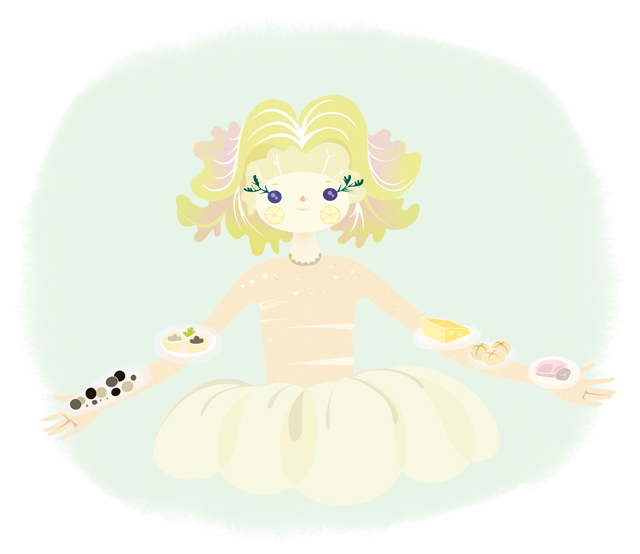 |
| Illustration by Anabel Bouza |
Not only is my intention to improve my own health, but also the health of those who benefit from my cookery. Also, I have the suspicion that the progressive replacement of bad habits for good ones will be less likely to meet resistance from hesitant family members... Some may say it's sneaky, I call it the cook's prerogative!
Hearty winter foods are moving aside in favor of lighter spring-summer fare: the time is right to change things up, and the benefits are plentiful.
Banish temptation. Don't bring into your home the foods you are trying to avoid.
This sounds obvious, but sometimes we set up traps for our future selves inadvertently: think of future you (eat-at-home you), when you're debating whether to buy that guilty snack or not.
Instead of setting up the stage for a wrestling match with yourself later ("Should I have another piece of that salted chocolate caramel?") just leave it on the market shelf.
If you're trying to eat out less, spice up your eat-at-home routine.
Some people do this by creating a choose-your-own-adventure kind of spread: customizing homemade pizzas with fun, healthy toppings, for example. The idea is to serve simply cooked dishes, in small proportions, and to relish the occasion.
Our own version of this involves tapas, those tasty Spanish appetizers. They're a break from the usual 'finish your plate' approach, and make the occasion feel celebratory. You get to sample and mix... and sampling is always fun, right?
In a perfect world, portions would be perfectly sized to fit our needs and not a spoonful more, and there would be no food left on the plate — the #1 cause of upset among grandmothers everywhere. I've been trying to balance the art of the sensibly portioned meal, with the Hara Hachi Bu approach.
Hara Hachi Bu is the practice of eating until you are 8/10 parts full, customary among the residents of Okinawa, Japan.
(Really, it is just common sense: it takes roughly 20 minutes for the brain to register that you've eaten, so when you eat up to the point of feeling full —without giving the brain time to catch up— you end up over eating, in fact.)
This knowledge has already proven handy: it keeps me for 'going for seconds', or overeating when going out, since restaurants' portions usually are one-fits-all.
In a perfect world, portions would be perfectly sized to fit our needs and not a spoonful more, and there would be no food left on the plate — the #1 cause of upset among grandmothers everywhere. I've been trying to balance the art of the sensibly portioned meal, with the Hara Hachi Bu approach.
Hara Hachi Bu is the practice of eating until you are 8/10 parts full, customary among the residents of Okinawa, Japan.
(Really, it is just common sense: it takes roughly 20 minutes for the brain to register that you've eaten, so when you eat up to the point of feeling full —without giving the brain time to catch up— you end up over eating, in fact.)
This knowledge has already proven handy: it keeps me for 'going for seconds', or overeating when going out, since restaurants' portions usually are one-fits-all.
And finally, something I adopted from one of my favorite science podcasts, a reminder to tackle food-shopping mindfully. After all, what we eat informs us, and it all starts with the ingredients we choose.
'Whatever I put in the shopping cart is what my body will use to build the next version of itself.'
'Whatever I put in the shopping cart is what my body will use to build the next version of itself.'
Now it's your turn, what can make you change your eating habits?
This post is part of Eat Healthier month on Kanelstrand. Read the rest of the posts here and join in the discussions, we'd love to know what you think!
Anabel Bouza insists there's powerful magic in the action of creating something out of a vague vision, a chill of inspiration. She is an illustrator with a passion for nature, paper manipulation, and pointing her camera at things.
Her appreciation for simplicity dates back to a former life in Cuba - her strange homeland - where she refined the ability to see the alternative uses of common objects, and the enchanting side of things. She's often found blogging as Weird Amiga, hard at work in her sunny studio, or staring at things as if looking at them for the first time. Her tiny family is comprised of husband & a turtle. Connect to Anabel via facebook and twitter.
Anabel Bouza insists there's powerful magic in the action of creating something out of a vague vision, a chill of inspiration. She is an illustrator with a passion for nature, paper manipulation, and pointing her camera at things.
Her appreciation for simplicity dates back to a former life in Cuba - her strange homeland - where she refined the ability to see the alternative uses of common objects, and the enchanting side of things. She's often found blogging as Weird Amiga, hard at work in her sunny studio, or staring at things as if looking at them for the first time. Her tiny family is comprised of husband & a turtle. Connect to Anabel via facebook and twitter.
21 March 2013
How to Choose Your Diet
It is amazing how much our lives are centered around food. It is natural, of course, since consuming food not only fuels our bodies but also our emotions. (Hello, emotional eaters!)
But how do you chose your diet? Do you base your decision upon fashion, religion or phase in life?
I don't blame people who eat junk food, I think there comes a moment in life when something clicks, your eyes open wide and you are able to see what used to be invisible before. This enlightenment happens to all of us and when we look back we cannot fathom how we were able to eat such unhealthy diet for so long and get away with it.
But not all get away with a bad diet. The influence of diet upon health has been proven and a lot of research shows the benefits of eating organic, raw, vegetarian and even vegan.
But there is also a great deal of contradicting research. With the advance of the Internet age the information becomes more and more. Now picture yourself in the middle of this vast ocean of information. How do you know where to look? How do you know what to believe? Here is the latest post by Elephant Journal disclosing worrying information about eating organic: Eating Organic May be Harmful.
I take pride in imposing a healthy diet on my family. We eat a lot salads, fruits, but we also eat meat, a few times a month, mostly chicken. We eat plenty of fish, grains and seeds. We love feta cheese and yogurt, the one with Lactobacillus bulgaricus that will ensure we live to 100. We don't drink soft fizzy drinks, and when it comes to sweets, we mostly eat dark chocolate, 70% cocoa. We have replaced sugar with Stevia and drink a lot of water.
Is this enough though? Should I chose a label and put it on my diet? Maybe tweak a bit? If you are asking yourself the same questions, follow along to a pro and con review of some of the most popular diets.
Vegetarian
Could you easily go without meat? The vegetarian diet might be for you.
Vegetarianism is the practice of abstaining from the consumption of meat - red meat, poultry, seafood and the flesh of any other animal; it may also include abstention from by-products of animal slaughter, such as animal-derived rennet and gelatin.
Pros
Vegan
Don't care much about meat and animal products? How about becoming a vegan?
Veganism is the practice of abstaining from the use of animal products, particularly in diet, as well as an associated philosophy that rejects the commodity status of sentient animals.
Pros
Raw
Do you think you could live on uncooked vegetables and stay away from meat, animal products and baked products? Consider embracing the raw food diet.
Raw foodism (or rawism) is a diet consisting of uncooked, unprocessed, and often organic foods or wild foods. Depending on the type of lifestyle and results desired, raw food diets may include a selection of raw fruits, vegetables, nuts, seeds (including sprouted whole grains such as gaba rice), eggs, fish (such as sashimi), meat (such as carpaccio), and non-pasteurized/non-homogenized dairy products (such as raw milk, raw milk cheese, and raw milk yogurt).
Pros
Cons
What if you like seafood? You might add a twist to vegetarianism by becoming a pescetarian.
Pescetarianism is the practice of a diet that includes seafood but not the flesh of other animals. A pescetarian diet shares many of its components with a vegetarian diet and includes vegetables, fruit, nuts, grains, beans, eggs, and dairy, but unlike a vegetarian diet also includes fish and shellfish. The Merriam-Webster dictionary dates the origin of the term "pescetarian" to 1993 and defines it to mean: "one whose diet includes fish but no other meat".
Pros
Cons
Paleo
Are you allergic to milk but love meat? Would you feel fine if you left refined sugar and salt behind? Consider the paleolithic diet.
The paleolithic diet, also known as the caveman diet, Stone Age diet and hunter-gatherer diet, is a modern nutritional plan based on the presumed ancient diet of wild plants and animals that various hominid species habitually consumed during the Paleolithic era, which ended around 10,000 years ago with the development of agriculture and grain-based diets. Centered on commonly available modern foods, the "contemporary" Paleolithic diet consists mainly of fish, grass-fed pasture raised meats, eggs, vegetables, fruit, fungi, roots, and nuts, and excludes grains, legumes, dairy products, potatoes, refined salt, refined sugar, and processed oils.
Pros
Cons
Gluten-free
Do you have celiac disease? This is the only reason to go on a gluten-free diet.
The gluten-free diet excludes foods containing gluten -- the protein complex found in wheat, barley, rye and triticale. Corn and rice also contain gluten, but are considered gluten-free, as the gluten in these species do not cause celiac disease. A gluten-free diet is the only medically accepted treatment for celiac disease, the related condition dermatitis herpetiformis, and wheat allergy, but not gluten allergy. Although the gluten-free diet has recently become a fad, there is no evidence to suggest that following a gluten-free diet has any significant benefits in the general population. On the contrary, there is some evidence to suggest that a gluten-free diet may adversely affect gut health in those without celiac disease or gluten sensitivity.
Pros
Cons
Feeling confused? Don't worry, you are not alone. There is so much conflicting information regarding healthy eating and proper nutrition. If you want to get some questions answered (or possibly get even more confused), I would like to encourage you to attend THE HEALTHY LIFE SUMMIT, March 24-30, 2013, it's free! You will learn about metabolism and stress, the war on milk, techniques for making real food, how to recover from autism with diet, and so much more. Here is a short preview of the wealth of information that awaits you on the summit.
But while the experts continue the battle over the best diet, you can rest assured that there is no right diet for everyone. You need to eat a diet that feels right for you, gives you energy, increases your health, and strong physics. Balance is the only answer.
Now is your turn, what are your eating habits and do you plan on changing them?
Resources:
http://features.peta.org/VegetarianStarterKit/
http://www.sixwise.com/
health-mind-body.com/
http://www.livestrong.com/
http://en.wikipedia.org/wiki/List_of_diets
This post is part of Eat Healthier month on Kanelstrand. Read the rest of the posts here and join in the discussions, we'd love to know what you think!
But how do you chose your diet? Do you base your decision upon fashion, religion or phase in life?
I don't blame people who eat junk food, I think there comes a moment in life when something clicks, your eyes open wide and you are able to see what used to be invisible before. This enlightenment happens to all of us and when we look back we cannot fathom how we were able to eat such unhealthy diet for so long and get away with it.
But not all get away with a bad diet. The influence of diet upon health has been proven and a lot of research shows the benefits of eating organic, raw, vegetarian and even vegan.
But there is also a great deal of contradicting research. With the advance of the Internet age the information becomes more and more. Now picture yourself in the middle of this vast ocean of information. How do you know where to look? How do you know what to believe? Here is the latest post by Elephant Journal disclosing worrying information about eating organic: Eating Organic May be Harmful.
I take pride in imposing a healthy diet on my family. We eat a lot salads, fruits, but we also eat meat, a few times a month, mostly chicken. We eat plenty of fish, grains and seeds. We love feta cheese and yogurt, the one with Lactobacillus bulgaricus that will ensure we live to 100. We don't drink soft fizzy drinks, and when it comes to sweets, we mostly eat dark chocolate, 70% cocoa. We have replaced sugar with Stevia and drink a lot of water.
Is this enough though? Should I chose a label and put it on my diet? Maybe tweak a bit? If you are asking yourself the same questions, follow along to a pro and con review of some of the most popular diets.
 |
| Source |
Could you easily go without meat? The vegetarian diet might be for you.
Vegetarianism is the practice of abstaining from the consumption of meat - red meat, poultry, seafood and the flesh of any other animal; it may also include abstention from by-products of animal slaughter, such as animal-derived rennet and gelatin.
Pros
- Vegetarians are 50% less likely to develop heart disease, and they have a 40 percent lower cancer rate of meat-eaters.
- Meat-eaters are nine times more likely to be obese than vegans (who don't eat any animal products) are.
- Vegetarians have stronger immune systems than meat-eaters.
- Vegetarians and vegans live, on average, six to 10 years longer than meat-eaters.
- According to the Weston A. Price Foundation, a vegetarian diet is far from ideal, mostly because it lacks animal fats, which some experts say are necessary for human health.
- 2 in 3 vegetarians are vitamin B12 deficient compared to 1 in 20 meat eaters according to a peer-reviewed July 2003 study in the American Journal of Clinical Nutrition.
- According to Weston A. Price Foundation Vegetarianism that includes eggs and raw (unpasteurized) dairy products, organic vegetables and fruits, properly prepared whole grains, legumes, and nuts, and excludes unfermented soy products and processed foods, can be a healthy option for some people. However, some people have difficulty assimilating vitamins, minerals, protein, and other factors from plant foods. These individuals may need a higher proportion of nutrients from animal foods to achieve optimum health.
- Vegetarians may tend to eat too many grains as they shy away from meat. Eating too much grain, especially if it is processed white flour, can lead to weight gain. Eating sweets instead of protein increases your sugar intake which is even worse.
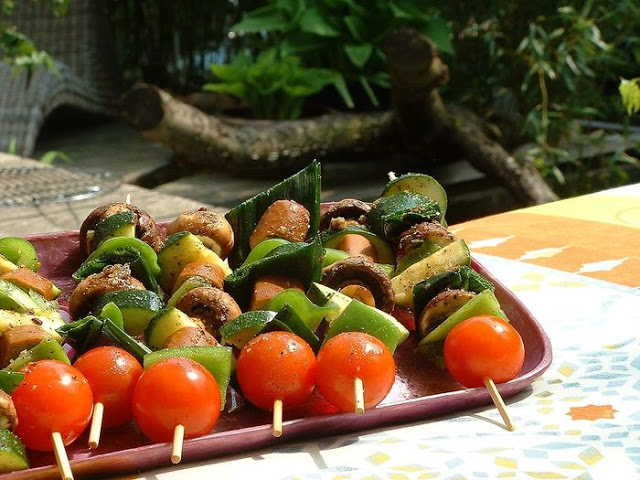 |
| Vegan shashlik |
Don't care much about meat and animal products? How about becoming a vegan?
Veganism is the practice of abstaining from the use of animal products, particularly in diet, as well as an associated philosophy that rejects the commodity status of sentient animals.
Pros
- May help lower cholesterol: According to a study in Diabetes Voice in 2007 people with Type 2 diabetes who adopted a vegan diet reduced their LDL (low density lipoprotein) cholesterol by 21 percent — significantly more than the 9 percent drop seen by another group on the American Diabetes Association diet.
- May help lower blood pressure: According to a 2009 position paper of the American Dietetic Association, vegetarian eating is linked with decreased risk of death from ischemic heart disease. The report also concluded that people who eat a vegetarian diet tend to have lower LDL levels and less incidence of hypertension and Type 2 diabetes in comparison to non-vegetarian
- Increases antioxidant intake: Vegan eating usually increases intake of wholesome foods such as vegetables, fruits, beans, legumes and whole grains, which is a great opportunity to get plentiful antioxidants, dietary fiber and vitamins and minerals.
- Potential interference with existing medical conditions: If you have a condition such as osteoporosis or diabetes, it is critical to consult with your physician and a registered dietitian when starting and implementing a vegan eating plan, as a vegan diet may interfere with your condition.
- Loss of essential vitamins and minerals: There is evidence to show vegan diets do not contain vitamin B12, an essential nutrient. "Vegans can get vitamin B12 from fortified foods (some brands of soy milk, fake meats, breakfast cereals and nutritional yeast) and from supplements. Vegan diets may be low in calcium and vitamin D although there are vegan sources of these nutrients," says Reed Mangels, PhD, RD, nutrition advisor for The Vegetarian Resource Group (vrg.org).
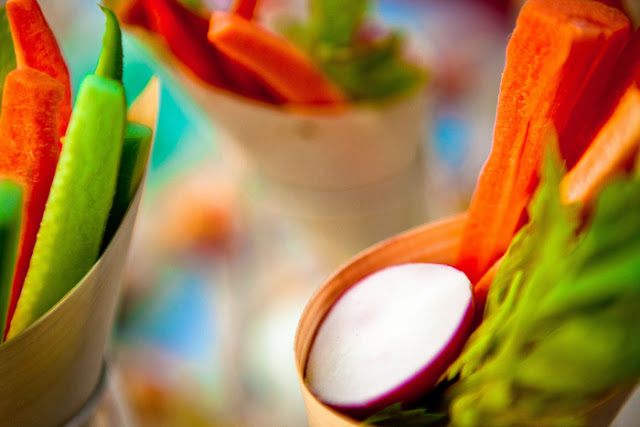 |
| Raw food |
Do you think you could live on uncooked vegetables and stay away from meat, animal products and baked products? Consider embracing the raw food diet.
Raw foodism (or rawism) is a diet consisting of uncooked, unprocessed, and often organic foods or wild foods. Depending on the type of lifestyle and results desired, raw food diets may include a selection of raw fruits, vegetables, nuts, seeds (including sprouted whole grains such as gaba rice), eggs, fish (such as sashimi), meat (such as carpaccio), and non-pasteurized/non-homogenized dairy products (such as raw milk, raw milk cheese, and raw milk yogurt).
Pros
- Increases the level of energy and body health.
- Beneficial to the skin.
- Positively improves your digestion and helps you lose weight.
- Decreases the chances of developing heart and cardiovascular diseases.
Cons
- I will start by opposing one of the pros above. According to a German study that gathered data on subjects whose diets consisted of at least 70 percent raw foods -- primarily fruits and vegetables, the raw food diet had a positive effect on levels of "bad" cholesterol and triglycerides, but it appeared to raise levels of homocysteine -- a type of amino acid believed to increase your risk of heart disease -- and lower levels of the "good" cholesterol that protects the heart.
- According to a number of studies, the raw food diet increases death rates from heart disease compared to a vegetarian diet that includes dairy and eggs.
- Read this mind boggling article by a well-known raw food author, admitting that due to health problems she couldn't continue with her vegan/raw-food lifestyle. Kristen's confession answered a lot of questions I have been asking myself.
What if you like seafood? You might add a twist to vegetarianism by becoming a pescetarian.
Pescetarianism is the practice of a diet that includes seafood but not the flesh of other animals. A pescetarian diet shares many of its components with a vegetarian diet and includes vegetables, fruit, nuts, grains, beans, eggs, and dairy, but unlike a vegetarian diet also includes fish and shellfish. The Merriam-Webster dictionary dates the origin of the term "pescetarian" to 1993 and defines it to mean: "one whose diet includes fish but no other meat".
Pros
- Pescetarians consume enough Omega-3 fatty acids found in fish, which ensures them a healthy heart. If you have a desire to be vegetarian but are concerned about getting adequate amounts of Omega-3 fatty acids, you might want to try flaxseed oil. It can be added to many recipes during food preparation, and it's virtually undetectable in smoothies. You can take a flaxseed oil supplement as well.
- Seafood is a good source of iron. Because of this, pescetarians are at a much lower risk of having iron deficiency, which is common amongst vegans and vegetarians.
Cons
- Depending on the quantity and type of fish you eat as a pescetarian, excess mercury consumption might be a concern. To minimize your exposure to mercury, limit your consumption of larger fish. This is particularly important if you're pregnant. If you're pregnant, ask your obstetrician what types of fish and how much fish you can safely consume. Reduce your exposure to mercury by buying wild fish rather than farm-raised whenever possible. The only downside is cost; wild fish is typically more expensive. Change the variety of fish you eat so you don't consume an abundance of any one particular fish. What you need to know about mercury in fish and shellfish.
- The pescetarian diet severely limits your protein sources.
 |
| Pork chops |
Are you allergic to milk but love meat? Would you feel fine if you left refined sugar and salt behind? Consider the paleolithic diet.
The paleolithic diet, also known as the caveman diet, Stone Age diet and hunter-gatherer diet, is a modern nutritional plan based on the presumed ancient diet of wild plants and animals that various hominid species habitually consumed during the Paleolithic era, which ended around 10,000 years ago with the development of agriculture and grain-based diets. Centered on commonly available modern foods, the "contemporary" Paleolithic diet consists mainly of fish, grass-fed pasture raised meats, eggs, vegetables, fruit, fungi, roots, and nuts, and excludes grains, legumes, dairy products, potatoes, refined salt, refined sugar, and processed oils.
Pros
- The Paleo diet is one of few diets to manage to offer a sufficient amount of potassium, which decreases bone loss, and reduces the risk of developing kidney stones.
- Eliminates reliance on white refined carbohydrates.
- By embracing the Paleo diet you will certainly eat lots of vegetables.
- No more processed snack foods, which are high in calories and low in nutrients.
Cons
- Calcium is essential not only to build and maintain bones but to make blood vessels and muscles function properly. Because you’re not allowed dairy or fortified cereals, you’ll likely only get about half of the recommended daily amount from a Paleo menu.
- Beans and whole grains, which are not allowed in the Paleo diet, are an important source of nutrients and fiber, plus an eco-friendly source of protein.
- Refraining from legumes and whole grains has been shown to increase the risk of disease and heighten insulin sensitivity and blood glucose levels, not to mention increase BMI.
- The Paleo diet is too hard to maintain over a long period of time, which leads to yo-yo dieting and can mean poorer health.
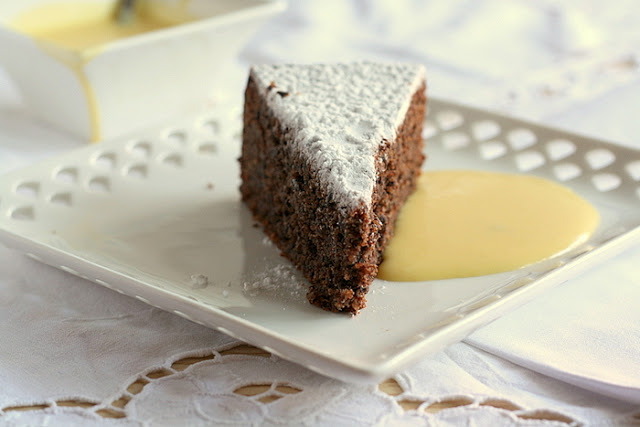 |
| Gluten-free Caprese |
Do you have celiac disease? This is the only reason to go on a gluten-free diet.
The gluten-free diet excludes foods containing gluten -- the protein complex found in wheat, barley, rye and triticale. Corn and rice also contain gluten, but are considered gluten-free, as the gluten in these species do not cause celiac disease. A gluten-free diet is the only medically accepted treatment for celiac disease, the related condition dermatitis herpetiformis, and wheat allergy, but not gluten allergy. Although the gluten-free diet has recently become a fad, there is no evidence to suggest that following a gluten-free diet has any significant benefits in the general population. On the contrary, there is some evidence to suggest that a gluten-free diet may adversely affect gut health in those without celiac disease or gluten sensitivity.
Pros
- Some people have a condition “where gluten damages the little fingerlike vili in their small intestines, causing discomfort in their bowels. They may also have constipation, diarrhea or blood in their stool. The condition is diagnosed through blood test and biopsy. Depending on the results, the diagnosis will be either celiac disease or gluten sensitivity. These patients must follow a gluten-free diet throughout their lives. If you suspect you have celiac disease and would like to be tested, it’s important to eat regularly and not follow a gluten-free diet, as this may skew results.
- Because of the restriction of gluten, a greater emphasis is put on fruits and vegetables, which are often lacking in the typical American diets.
Cons
- If you’re following a gluten-free diet with the intent of losing weight, you’re often eliminating entire categories of food — such as whole-grain breads — and as a result you run the risk of cutting out sources of necessary vitamins, particularly the B vitamins, niacin, folic acid, iron and zinc.
- With a gluten-free diet you might chose less healthy foods. Often people substitute high-fat items for the gluten. A label may say the product is gluten-free, but it may be high in fat or sugar.
Feeling confused? Don't worry, you are not alone. There is so much conflicting information regarding healthy eating and proper nutrition. If you want to get some questions answered (or possibly get even more confused), I would like to encourage you to attend THE HEALTHY LIFE SUMMIT, March 24-30, 2013, it's free! You will learn about metabolism and stress, the war on milk, techniques for making real food, how to recover from autism with diet, and so much more. Here is a short preview of the wealth of information that awaits you on the summit.
But while the experts continue the battle over the best diet, you can rest assured that there is no right diet for everyone. You need to eat a diet that feels right for you, gives you energy, increases your health, and strong physics. Balance is the only answer.
Now is your turn, what are your eating habits and do you plan on changing them?
Resources:
http://features.peta.org/VegetarianStarterKit/
http://www.sixwise.com/
health-mind-body.com/
http://www.livestrong.com/
http://en.wikipedia.org/wiki/List_of_diets
This post is part of Eat Healthier month on Kanelstrand. Read the rest of the posts here and join in the discussions, we'd love to know what you think!
18 March 2013
The Most Delicious Rye Bread
I grew up on wheat bread -- warm, soft, crispy crusted and incredibly delicious. We called it "white bread" as opposed to the black one -- the rye bread that my grandfather who had diabetes used to eat.
When I started my own family and entered the world of bread baking little did I know that this was a step to simple living but by creating food as essential as bread from scratch I intuitively felt independent, grown-up and free.
7 years into the journey, my strictly wheat flour bread repertoire has been met with applause but today I want to share with you the latest baked favorite in our household -- the most delicious and rich rye bread recipe that I made up myself.
It is appropriate for those of you who have never even baked bread because it is so easy. With rye you don't have any of the difficulties you will meet in wheat baking.
Rye bread is naturally more wet and doesn't rise as much as "white bread" but with some additions you can turn it into a hearty and healthy meal!
For this recipe I also used a little bit of barley and wheat flours. We don't have any gluten problems at home and I believe that moderation is key to health, so they shouldn't be a problem in the proportions used. But if you follow a gluten-free diet you can substitute them with any other gluten-free flours.
Confession: I tend to use recipes for general ideas and usually change half of them in the process of cooking. I encourage you to do the same and not stick 100% to any recipe but personalize it according to your taste and needs.
The Most Delicious Rye Bread
Produces two middle sized loaves
Start by pouring 1 cup of boiling water over the rolled oats, add 3 tablespoons honey and leave to soak for about 15 minutes or until all the water is absorbed.
Dilute the yeast together with the sugar in 1 2/3 cups water. Let rise for 15 minutes. I always do this regardless of what kind of yeast I use, just to check whether it is active.
In a large bowl combine the flours, salt, cacao, the flax seed and the sunflower seeds. Mix well. Make a well in the center and transfer the rolled oats. Pour the risen yeast.
It's time to get your hands dirty. First try to break the oats (they should look like a stiff paste) and then start working the flour into the liquid center. Continue until you have a sticky but manageable dough.
In the adventurous baking spirit I would advise you to decide for yourself whether the dough is hard enough for your taste. It shouldn't be rock hard and it shouldn't be runny either. You might need to add some more flour or water.
Place the dough in lightly oiled clean bowl, grease on top, cover and let rise for about an hour in a warm place. Knead a little bit more and form into a loaf.
Transfer to a greased form (or two in my case). Make a decorative cut and let rise again for about 30 minutes.
Brush top with water and bake in a preheated oven at 180 °C (356 °F) for 1 hour or until the bread sounds hollow when you tap it.
You should wait for 24 hours before you eat this incredibly delicious bread. In fact, the longer it stays the tastier it becomes.
I love eating it for breakfast with a swipe of butter, a slice of cheese and a cucumber, salad or spinach leaves for freshness.
Mmm, my mouth is watering as I write, I'd better start baking my next batch!
Now it's your turn. What is your favorite rye bread recipe? If you haven't baked so far what could make you try?
This post is part of Eat Healthier month on Kanelstrand. Read the rest of the posts here and join in the discussions, we'd love to know what you think!
When I started my own family and entered the world of bread baking little did I know that this was a step to simple living but by creating food as essential as bread from scratch I intuitively felt independent, grown-up and free.
7 years into the journey, my strictly wheat flour bread repertoire has been met with applause but today I want to share with you the latest baked favorite in our household -- the most delicious and rich rye bread recipe that I made up myself.
It is appropriate for those of you who have never even baked bread because it is so easy. With rye you don't have any of the difficulties you will meet in wheat baking.
Rye bread is naturally more wet and doesn't rise as much as "white bread" but with some additions you can turn it into a hearty and healthy meal!
For this recipe I also used a little bit of barley and wheat flours. We don't have any gluten problems at home and I believe that moderation is key to health, so they shouldn't be a problem in the proportions used. But if you follow a gluten-free diet you can substitute them with any other gluten-free flours.
Confession: I tend to use recipes for general ideas and usually change half of them in the process of cooking. I encourage you to do the same and not stick 100% to any recipe but personalize it according to your taste and needs.
The Most Delicious Rye Bread
Produces two middle sized loaves
- 3 cups rye flour (coarsely ground)
- 1 cup barley flour
- 1 cup wheat flour
- 1 cup rolled oats
- 1/3 cup flax seed (crushed)
- 2/3 sunflower seeds
- 1 2/3 cups water
- 1 cup boiling water
- 3 tablespoons honey
- 3 tablespoons sugar
- 1 tablespoon salt
- 1 tablespoon unsweetened cacao
- yeast for 2 kg (4,50lb) flour, this is roughly double the actual weight of the ingredients.
Start by pouring 1 cup of boiling water over the rolled oats, add 3 tablespoons honey and leave to soak for about 15 minutes or until all the water is absorbed.
Dilute the yeast together with the sugar in 1 2/3 cups water. Let rise for 15 minutes. I always do this regardless of what kind of yeast I use, just to check whether it is active.
In a large bowl combine the flours, salt, cacao, the flax seed and the sunflower seeds. Mix well. Make a well in the center and transfer the rolled oats. Pour the risen yeast.
It's time to get your hands dirty. First try to break the oats (they should look like a stiff paste) and then start working the flour into the liquid center. Continue until you have a sticky but manageable dough.
In the adventurous baking spirit I would advise you to decide for yourself whether the dough is hard enough for your taste. It shouldn't be rock hard and it shouldn't be runny either. You might need to add some more flour or water.
Place the dough in lightly oiled clean bowl, grease on top, cover and let rise for about an hour in a warm place. Knead a little bit more and form into a loaf.
Transfer to a greased form (or two in my case). Make a decorative cut and let rise again for about 30 minutes.
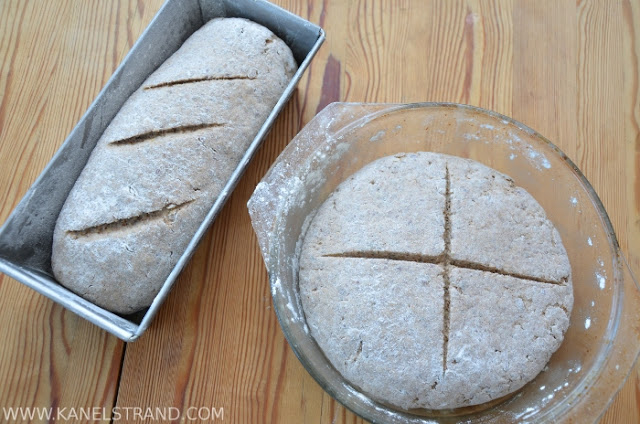 |
| This is how my loaves looked before rising. |
You should wait for 24 hours before you eat this incredibly delicious bread. In fact, the longer it stays the tastier it becomes.
I love eating it for breakfast with a swipe of butter, a slice of cheese and a cucumber, salad or spinach leaves for freshness.
Mmm, my mouth is watering as I write, I'd better start baking my next batch!
Now it's your turn. What is your favorite rye bread recipe? If you haven't baked so far what could make you try?
This post is part of Eat Healthier month on Kanelstrand. Read the rest of the posts here and join in the discussions, we'd love to know what you think!
15 March 2013
Make A Plan To Eat Healthy
This post is written by contributing author Shelly Kerry.
My experience has been that in order to eat healthier foods and to get well rounded nutritious meals, I need to accept that I will be shopping more often. Organic vegetables and fruits only last a few days on my counter before they start to go bad. Just a note - I do live alone so I buy less at a time. The best way I have tackled this is to first make a list of my weekly “to buys”including avocados, eggs, bread, 4 to 5 seasonal fruits and greens, lean meats and a seafood. I have accepted that the fruits and veggies will have to be purchased two or three times a week. This can feel like a lot but there are several ways to prevent getting overwhelmed by so much shopping.
Plan your shopping trips around other tasks
There is a farmers market near my gym on Thursdays and another one not too far from my home on Saturdays. I plan my workout schedule with my shopping. After the gym on Thursday, I stock up on healthy snacks of whatever is in season from the local farms. Saturday I take a longer walk and do other errands on my way to the larger weekend farmers market. Here I can pick up more things that will last an entire week - meat, seafood, dairy and bread. My walk home is a little more challenging with the weight of the bags but it gives me an excuse to indulge in a small, yummy maybe not so healthy treat. With all this healthy living, we deserve a small cookie or ice coffee beverage on the weekends.
Cook in batches
This is something I hope to get better at this year - I want one of my weekends nights to be spent preparing food for the week. I keep things pretty simple so meals are easy to prepare. This way I can enjoy the once a week dinner out with friends. Cook up chicken or turkey and portion it out for the week. Cook up a couple different grains to use as a side dish or in a salad. Cut up veggies for easy stir fries or snacks. I often have to take my dinner to my night job so I like to keep food ready to just throw in my bag. Soups are also a great easy thing to make in advance and freeze for later
Make it last
I am not a big fan of leftovers unless I can use them to create a whole new dish. If there are extra green beans or red potatoes, I will add them to a big salad for dinner. Chicken can be used both as a good protein for dinner and as a healthy after workout sandwich. Extra tomatoes can be added to an easy, homemade pasta sauce. Living alone I have to be really good about catching fruits and veggies before they go bad. As soon a fruit starts to look a little overripe, I either dice or puree and then freeze them so they are ready for smoothies. Same for veggies. Use extra ice cube trays to fill with purees and put them in the freezer.
Eating and living healthy takes effort but the benefits do outweigh the extra work. Make it a little easier on yourself by trying out some of the above tricks and creating a weekly healthy shopping list. Subscriptions to CSA boxes from local farmers can be fun especially if you like surprises and want to try new things. I haven’t tried it yet but Instacart, a local grocery shopping and delivery app is now delivering from Whole Foods. The charges are not too crazy and with such a busy schedule grocery delivery in big cities can be worth the extra change.
This post is part of Eat Healthier month on Kanelstrand. Read the rest of the posts here and join in the discussions, we'd love to know what you think!
I am a lady that needs a plan! I love schedules, notebooks and calendars and when it comes to eating healthy, I need a well laid out plan more than ever. With such a busy schedule it is easy for me to just eat whatever is quickest even if that is another peanut butter sandwich for dinner. Not really the well rounded diet I want for myself. So I have found that I do best by filling my fridge and cupboards with healthy, easy to make foods and to lay out a shopping plan for the week. For both my diet and my workouts, I make a weekly plan in advance and keep the menu and exercises simple.
My experience has been that in order to eat healthier foods and to get well rounded nutritious meals, I need to accept that I will be shopping more often. Organic vegetables and fruits only last a few days on my counter before they start to go bad. Just a note - I do live alone so I buy less at a time. The best way I have tackled this is to first make a list of my weekly “to buys”including avocados, eggs, bread, 4 to 5 seasonal fruits and greens, lean meats and a seafood. I have accepted that the fruits and veggies will have to be purchased two or three times a week. This can feel like a lot but there are several ways to prevent getting overwhelmed by so much shopping.
Plan your shopping trips around other tasks
There is a farmers market near my gym on Thursdays and another one not too far from my home on Saturdays. I plan my workout schedule with my shopping. After the gym on Thursday, I stock up on healthy snacks of whatever is in season from the local farms. Saturday I take a longer walk and do other errands on my way to the larger weekend farmers market. Here I can pick up more things that will last an entire week - meat, seafood, dairy and bread. My walk home is a little more challenging with the weight of the bags but it gives me an excuse to indulge in a small, yummy maybe not so healthy treat. With all this healthy living, we deserve a small cookie or ice coffee beverage on the weekends.
Cook in batches
This is something I hope to get better at this year - I want one of my weekends nights to be spent preparing food for the week. I keep things pretty simple so meals are easy to prepare. This way I can enjoy the once a week dinner out with friends. Cook up chicken or turkey and portion it out for the week. Cook up a couple different grains to use as a side dish or in a salad. Cut up veggies for easy stir fries or snacks. I often have to take my dinner to my night job so I like to keep food ready to just throw in my bag. Soups are also a great easy thing to make in advance and freeze for later
Make it last
I am not a big fan of leftovers unless I can use them to create a whole new dish. If there are extra green beans or red potatoes, I will add them to a big salad for dinner. Chicken can be used both as a good protein for dinner and as a healthy after workout sandwich. Extra tomatoes can be added to an easy, homemade pasta sauce. Living alone I have to be really good about catching fruits and veggies before they go bad. As soon a fruit starts to look a little overripe, I either dice or puree and then freeze them so they are ready for smoothies. Same for veggies. Use extra ice cube trays to fill with purees and put them in the freezer.
Eating and living healthy takes effort but the benefits do outweigh the extra work. Make it a little easier on yourself by trying out some of the above tricks and creating a weekly healthy shopping list. Subscriptions to CSA boxes from local farmers can be fun especially if you like surprises and want to try new things. I haven’t tried it yet but Instacart, a local grocery shopping and delivery app is now delivering from Whole Foods. The charges are not too crazy and with such a busy schedule grocery delivery in big cities can be worth the extra change.
This post is part of Eat Healthier month on Kanelstrand. Read the rest of the posts here and join in the discussions, we'd love to know what you think!
Shelly is the founder of the
program Creating Space, Mindful Living - motivating and inspiring people
to run their businesses more efficiently. She helps others look at
their personal and professional lives and explore what is and isn’t
working. As a jewelry designer she has spent many years testing and
honing the skills and discipline needed to run your own creative
business while still having time for friends, family and fun. She puts
her wealth of experience to use in the Creating Space service - healthy
living advice to help keep you motivated and make the most out of your
already busy schedule. She will help you find both the physical and
emotional space so you can pursue your dreams and she’ll always insist
there’s time for yourself. You can also find Creating Space on Facebook or contact shelly@
13 March 2013
The Healthy Life Summit: Learn from the Best Experts on Healthy Food and Living
One of the main prerequisites for a simple and healthy life is eating healthy and that is why all throughout March we are discussing healthier diets and trying to dig deeper into the modern way of eating.
As part of our Eat Healthier month I am excited to invite you to THE HEALTHY LIFE SUMMIT - a FREE online virtual conference that is happening March 24-30, 2013.
For a week you will be able to listen to 35 of your favorite health experts, authors, doctors, bloggers, farmers and activists from the comfort of your own couch! They will be covering the following topics:
When you sign up, you'll get an email with log in information. Then go back on Sunday, March 24th and listen all week for free.
On each day during the summit, 5 presentations will be posted on the Healthy Life Summit website. They will be available for FREE, streaming for 24 hours.
To register for the summit, all you have to do is sign up on the Healthy Life Summit website. Upon registering, you will receive an email with all the information that they need in order to participate in the summit.
Throughout the summit, you will receive daily emails with instructions on how to listen to the interviews.
 Here is a list of the expert participants in the Healthy Eating category:
Here is a list of the expert participants in the Healthy Eating category:
Diane Sanfilippo, author of New York Times bestseller Practical Paleo - The 21-Day Sugar Detox
Bill Staley and Hayley Mason, authors of Make It Paleo - Make It Paleo
Julia Ross, author of The Mood Cure and The Diet Cure - Healing the Mind and Body with Food
Dr. Kaayla Daniel, author of the Whole Soy Story - Practice Safe Soy
Kelly the Kitchen Kop - Transitioning Your Family from Junk Food to Real Food
Mark McAfee, Organic Pastures Raw Dairy - The War on Milk
Jenny McGruther, Nourished Kitchen - Techniques for Making Real Food Easy & Affordable
If you cannot attend during the live sessions, don't worry, you can download the package with the recordings of the entire conference (35 interviews).
The price for the whole package is $199.
Preorder today for only $49 and save 75% through March 23rd!
The downloadable package includes recordings of the entire 7 day online conference (35 interviews) and will be available in two formats:
This post is part of Eat Healthier month on Kanelstrand. Read the rest of the posts here and join in the discussions, we'd love to know what you think!
As part of our Eat Healthier month I am excited to invite you to THE HEALTHY LIFE SUMMIT - a FREE online virtual conference that is happening March 24-30, 2013.
For a week you will be able to listen to 35 of your favorite health experts, authors, doctors, bloggers, farmers and activists from the comfort of your own couch! They will be covering the following topics:
- Healthy Eating
- Healthy Body
- Healthy Babies & Kids
- Healthy Living,
- Healthy World.
When you sign up, you'll get an email with log in information. Then go back on Sunday, March 24th and listen all week for free.
On each day during the summit, 5 presentations will be posted on the Healthy Life Summit website. They will be available for FREE, streaming for 24 hours.
To register for the summit, all you have to do is sign up on the Healthy Life Summit website. Upon registering, you will receive an email with all the information that they need in order to participate in the summit.
Throughout the summit, you will receive daily emails with instructions on how to listen to the interviews.
 Here is a list of the expert participants in the Healthy Eating category:
Here is a list of the expert participants in the Healthy Eating category: Diane Sanfilippo, author of New York Times bestseller Practical Paleo - The 21-Day Sugar Detox
Bill Staley and Hayley Mason, authors of Make It Paleo - Make It Paleo
Julia Ross, author of The Mood Cure and The Diet Cure - Healing the Mind and Body with Food
Dr. Kaayla Daniel, author of the Whole Soy Story - Practice Safe Soy
Kelly the Kitchen Kop - Transitioning Your Family from Junk Food to Real Food
Mark McAfee, Organic Pastures Raw Dairy - The War on Milk
Jenny McGruther, Nourished Kitchen - Techniques for Making Real Food Easy & Affordable
If you cannot attend during the live sessions, don't worry, you can download the package with the recordings of the entire conference (35 interviews).
The price for the whole package is $199.
Preorder today for only $49 and save 75% through March 23rd!
The downloadable package includes recordings of the entire 7 day online conference (35 interviews) and will be available in two formats:
- 35 Audio Recordings
- 35 Video Slideshows
This post is part of Eat Healthier month on Kanelstrand. Read the rest of the posts here and join in the discussions, we'd love to know what you think!
10 March 2013
Simple and Healthy: Salmon with Leeks and Carrots
As part of our healthy diet we try to eat fish at least twice a week. Living in Norway, our fish of choice is salmon. The following recipe became our favorite last winter and to be honest we find it hard not to eat it every day. The ease of preparation makes it the perfect dinner, especially combined with mashed potatoes, pasta or quinoa. The rich texture of the salmon, the freshness of the leeks and carrots produce a simple, light and very tasty dish. Also, it is a fast and easy way to include omega-3 fatty acids into your diet especially during the long and dark winter.
Ingredients:
By crisping one side of the salmon for a few minutes, and finishing it in the vegetable stock with the vegetables, it allows for the salmon to be done to perfection... every time!
How often do you eat fish and what is your favorite way to prepare it?
This post is part of Eat Healthier month on Kanelstrand. Read the rest of the posts here and join in the discussions, we'd love to know what you think!
Ingredients:
- 4 salmon steaks
- 1 leek
- 4 large carrots
- 200 ml vegetable stock
- 1/4 teaspoon salt
- 1/4 teaspoon mixed black pepper, paprika, cayenne pepper
- 4 tablespoons oil/butter of your choice (oils I recommend to use)
- 1. Season one side of the salmon steaks with salt and the pepper mixture.
2. Trim away the root end, tough outer leaves and 2 inches (5 cm) of the dark green tops of the leeks. Cut the leeks lengthwise and wash well to remove any grit and drain in a colander. Now cut into half-circles.
3. Wash and peel the carrots. Cut in circles.
4. Melt the butter or heat half of the oil in a large frying pan over medium-high heat. Cook 2 of the salmon steaks, seasoned side down until golden brown and no longer translucent in the center, about 4 minutes.
5. Turn the salmon steaks and add half of the leeks and carrots. Pour 100 ml of the vegetable stock and cook under a lid for about 5 minutes or until the stock has been reduced.
By crisping one side of the salmon for a few minutes, and finishing it in the vegetable stock with the vegetables, it allows for the salmon to be done to perfection... every time!
How often do you eat fish and what is your favorite way to prepare it?
06 March 2013
Garlic Honey and Coleslaw Dressing Recipe
This post is written by contributing author Cory Trusty.
Garlic is a common kitchen herb with many medicinal uses. It can help resolve colds, coughs, sore throat, and sinus infections. Externally it can be used for skin infections.
For chronic concerns, garlic helps reduce blood sugar and high blood pressure. It is also helpful to treat Malaria and boost immunity for AIDS. It is famous as a de-wormer. I remember my grandpa taking it powdered on everything.
The fresh garlic is the most potent to use medicinally, but I am just not one of those people who can handle a raw clove. The first time I tried raw whole garlic was in Belize. One of the locals was taking it raw and suggested I try it. Too strong for me! I prefer mine chopped fine in small amounts, cooked, or made up into garlic honey.
It's very simple to make garlic honey for medicinal or culinary use. Just chop up a whole garlic bulb: peel and chop the cloves. Chopping helps release Allicin -- the most potent chemical ingredient in garlic. Allicin is created when Allin reacts with the enzyme Allinase, which is activated when garlic is chopped or crushed. After your cloves are ready, put them in a clean pint jar. Cover with honey. I used raw wild flower honey. It takes a long time for the honey to seep through all the chopped cloves, so pour slowly.
The next step is to cover and label and date your jar and put it up in a cupboard for 2-4 weeks. You can use the honey with or without the garlic at the end of this time. The shelf life of garlic honey is 3 months. You can take this honey by the spoonful or add it to tea if you have a cough, cold or sore throat.
I love making coleslaw dressing with garlic honey. You too can give it a try. Here's what you need:
Have you tried garlic honey for medicinal use or as a salad dressing?
This post is part of Eat Healthier month on Kanelstrand. Read the rest of the posts here and join in the discussions, we'd love to know what you think!
Cory's Kanelstrand blog posts are licensed under Creative Commons. You are free to copy, distribute and adapt Cory's Kanelstrand content provided you attribute it to her by linking back to the original post as well as Cory's AquarianBath.com website.
Garlic is a common kitchen herb with many medicinal uses. It can help resolve colds, coughs, sore throat, and sinus infections. Externally it can be used for skin infections.
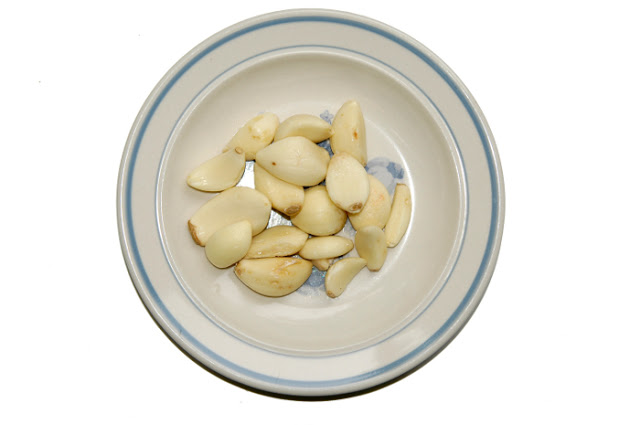 |
| Photo: Dreamstime |
The fresh garlic is the most potent to use medicinally, but I am just not one of those people who can handle a raw clove. The first time I tried raw whole garlic was in Belize. One of the locals was taking it raw and suggested I try it. Too strong for me! I prefer mine chopped fine in small amounts, cooked, or made up into garlic honey.
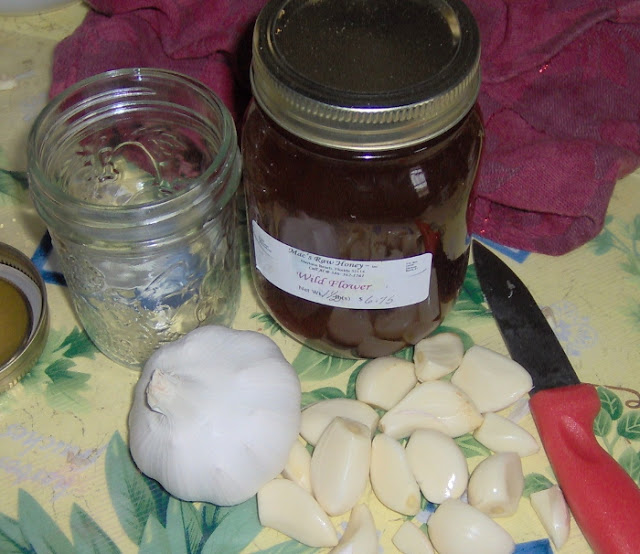 |
| Photo: Cory Trusty |
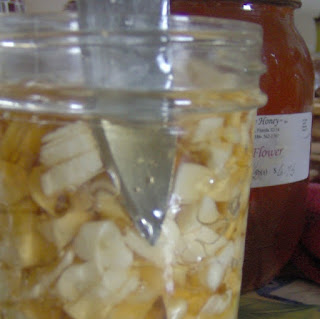 |
| You can use a knife or a chop stick to get the air bubbles out from among the chopped cloves. Photo: Cory Trusty |
I love making coleslaw dressing with garlic honey. You too can give it a try. Here's what you need:
- 3 tablespoons of herbal vinegar of your choice
- 3 tablespoons of Virgin Olive or Coconut oil
- 2-3 tablespoons of garlic honey
- 1/4 teaspoon mustard seed
- 1/4 teaspoon celery seed
- 1/4 teaspoon pepper
Have you tried garlic honey for medicinal use or as a salad dressing?
This post is part of Eat Healthier month on Kanelstrand. Read the rest of the posts here and join in the discussions, we'd love to know what you think!
Cory's Kanelstrand blog posts are licensed under Creative Commons. You are free to copy, distribute and adapt Cory's Kanelstrand content provided you attribute it to her by linking back to the original post as well as Cory's AquarianBath.com website.
Cory Trusty is
a soap maker, community herbalist, organic gardener, and homeschooling
mom to two girls. Cory and her family live in Daytona Beach, Florida.
Cory's background is in Traditional Chinese Medicine and Biology. She
is sharing tried and true natural home remedies and mini lessons from
herbal classes that she teaches. Cory works full time making soaps,
shampoo bars, herbal salves, flaxseed heat packs and more for her
website AquarianBath. Read more from Cory at the Aquarian Bath blog.
Cory is also a Food and Gardening writer for EcoEtsy and has published
in The Essential Herbal Magazine and on the Herb Companion Blog. Connect with Cory on Twitter, Facebook, Google Plus and Pinterest.
04 March 2013
Why I Bake My Own Bread
When we first met, my husband didn't even dream of me baking bread. I was that busy young woman too high in the professional hierarchy for my age that no one could picture wearing an apron.
The truth is that I was brought up by my mother and grandmother to respect slow food and cooking from scratch. In fact, I don't remember eating any processed or fast food well until my 20s.
My fascination with bread baking has always been active but although I spent long hours by my mother's side in the kitchen I never really felt myself ready to knead until I moved away from home.
For me, the pride to produce something as basic and as important as bread is incomparable to anything. But there is more to baking bread at home than ego. Kneading the dough by hand one transports her thoughts and emotions to the bread, making positivity and inspiration contagious. With this comes also a great responsibility -- to actually be positive while baking, to handle the dough lovingly, with warmth and care. Such a wonderful exercise for the spirit, don't you think?
Now is the time to mention that I don't use a bread machine exactly because I want to keep the connection with bread. I want to feed my family straight from my heart and I cannot let a machine do my job.
I have been baking my own bread for more than 10 years now and to those of you who have been afraid to try I can say, go ahead! I wont lie to you and say it is simple. But it is extremely satisfying and de-stressing.
Maybe your first loaf will not be perfect. You might even ruin it but taking the first step will open up a new road for you that is not only leading you to better health but to a whole universe of new knowledge and possibility to communicate with your inner self.
Stay tuned for some outstanding bread recipes that I will be sharing this month.
Now it's your turn - do you bake bread? How was your first time? Do you prefer a bread machine or your own bare hands?
This post is part of Eat Healthier month on Kanelstrand. Please, join in the discussion, we'd love to know what you think!
The truth is that I was brought up by my mother and grandmother to respect slow food and cooking from scratch. In fact, I don't remember eating any processed or fast food well until my 20s.
My fascination with bread baking has always been active but although I spent long hours by my mother's side in the kitchen I never really felt myself ready to knead until I moved away from home.
For me, the pride to produce something as basic and as important as bread is incomparable to anything. But there is more to baking bread at home than ego. Kneading the dough by hand one transports her thoughts and emotions to the bread, making positivity and inspiration contagious. With this comes also a great responsibility -- to actually be positive while baking, to handle the dough lovingly, with warmth and care. Such a wonderful exercise for the spirit, don't you think?
Now is the time to mention that I don't use a bread machine exactly because I want to keep the connection with bread. I want to feed my family straight from my heart and I cannot let a machine do my job.
I have been baking my own bread for more than 10 years now and to those of you who have been afraid to try I can say, go ahead! I wont lie to you and say it is simple. But it is extremely satisfying and de-stressing.
Maybe your first loaf will not be perfect. You might even ruin it but taking the first step will open up a new road for you that is not only leading you to better health but to a whole universe of new knowledge and possibility to communicate with your inner self.
Stay tuned for some outstanding bread recipes that I will be sharing this month.
Now it's your turn - do you bake bread? How was your first time? Do you prefer a bread machine or your own bare hands?
This post is part of Eat Healthier month on Kanelstrand. Please, join in the discussion, we'd love to know what you think!
Subscribe to:
Posts (Atom)
